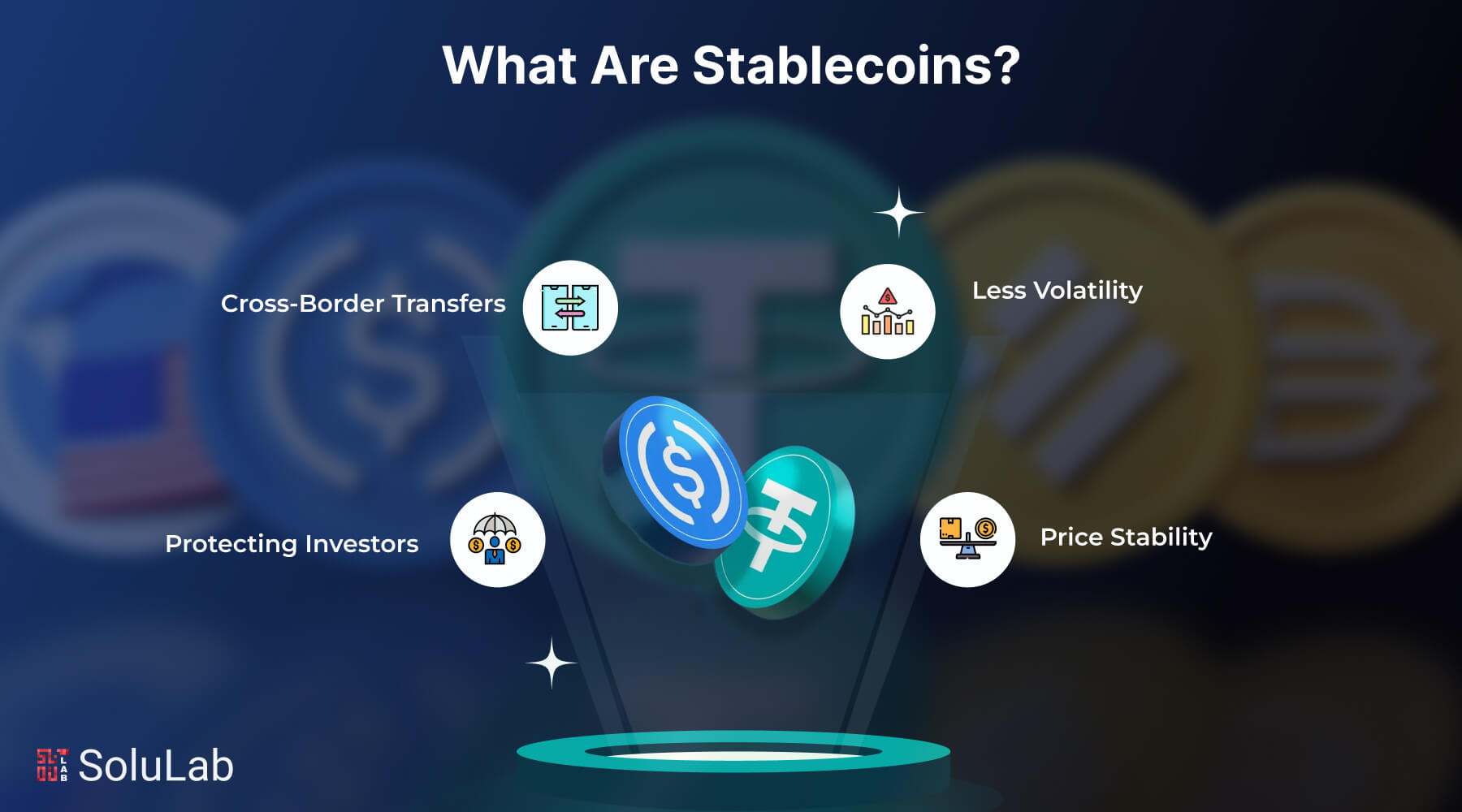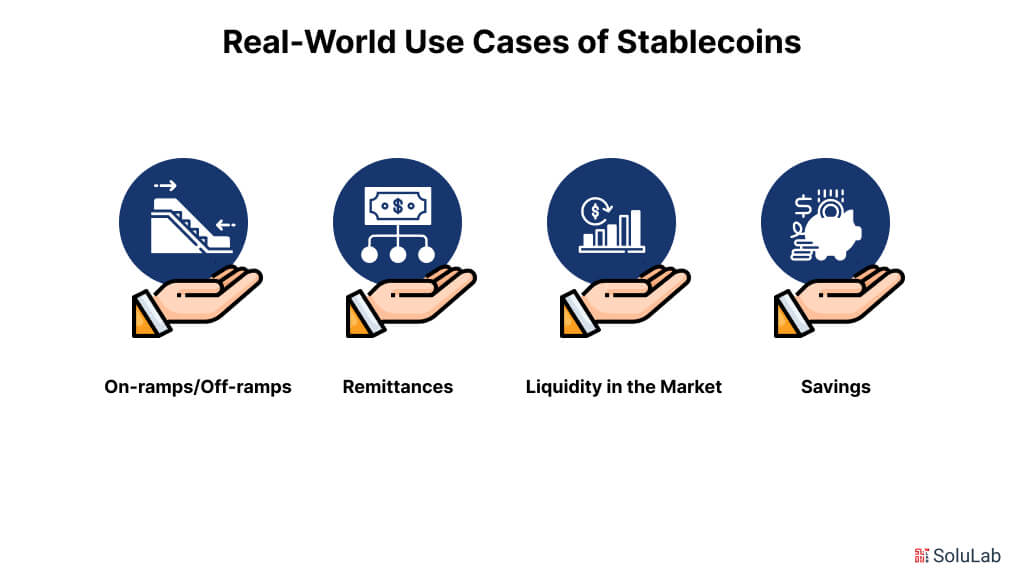
Stablecoins are emerging as the major player in the cryptocurrency space, acting as the point of interaction between digital assets and traditional finance systems. According to recent news from Bernstein, monthly settlement volumes have tripled over the past year to reach $1.14 trillion, as well as the total quantity of stablecoins has also increased to an unprecedented level of $170 billion. Stablecoins are currently the largest holder of US treasury bonds, demonstrating their significance in the dynamics.
With this article, you will dive into the definition of what a stablecoin is, its workings, and the reasons behind its growing significance in the financial sector. You will also find out the benefits it offers and how it links conventional finance and the rapidly expanding realm of digital assets.
What are Stable Coins?
A stablecoin is a form of digital currency whose value is dependent on the value of another kind of money, goods, or financial instrument. The extreme fluctuation of the most well-known cryptocurrencies such as Bitcoin (BTC), has rendered cryptocurrency investments less appropriate for use in day-to-day transactions, stablecoins seek to address this issue.
This implies that this is one of the blockchain solutions, that is one-to-one tethered to, say the US dollar ought to always be equal to $1, at least that’s the aim. As a means of exchange, stablecoins are more beneficial than erratic currencies. Stablecoins can be linked to the value of a commodity like gold or a currency like the US dollar. To achieve price stability, stablecoins can hold reserve funds as collateral or use mathematical formulas that are meant to regulate supply.
What Makes Stable Coins Special?
Since typical cryptocurrencies have short-term as well as long-term instability, usual consumers consider them extremely risky. Stability is needed before cryptocurrency can act as an actual method of directly replacing conventional fiat currency. Volatility is a big threat that can put at risk the buying power of a certain currency. As for stablecoins, you can apply digital currency while having no concerns about situations when its rates will drastically increase or decrease. The following is a list of features that make it special:
-
Less Volatility
From this perspective, the volatility of actors’ expectations appears to be either non-existent or negligible. You only have to glance at Bitcoin, the world’s first cryptocurrency, to see how volatile these things are. It is seen that the fee of Bitcoin has emerged from the ground and experienced a string of highs and lows since its delivery. For example, Bitcoin at some point early this year nearly hit $64,000, but before the year was over, it was trading below $30,000. It had risen to about $35000 in January 2022 before going down to $68000 in November 2021.
-
Cross-Border Transfers and Payment
Cross-border transactions carried out in the stablecoin surpass in their speed, cost, and efficiency factors the Western Union or SWIFT methods. Besides the high costs, the existing operations take days to process a single foreign payment. That is a real lot of extra weight and processing costs for payments which stablecoins could potentially get rid of. Recently, millions of dollars were transferred across the border of China and Russia using the Tether stablecoin.
Meanwhile, Hedera agreed with Standard Bank Group, the largest bank by assets in Africa in 2021. Hedera has a distributed public ledger and it enables convenient international transactions while offering absolute transparency to all parties. Financially backed stablecoins are considered by the public as a nobler species in comparison with other cryptocurrencies. The market price fluctuations for stablecoins are not as high as for traditional popular cryptocurrencies such as Ether or Bitcoin.
Check Out Our Blog Post: Stablecoin Development in Real Estate Transactions
-
Protecting the Investors in Cryptocurrencies
In addition, stablecoins assist in removing the volatility of crop-to-currency trading and protect investors from the unpredictable fluctuation of the market. In a bearish market, traders using Bitcoin, Ethereum or any other cryptocurrencies can easily convert their holdings quickly to stablecoin. Thus, traders can diversify their cryptocurrency portfolio, and use stablecoins to enter or leave the markets without conversion into fiat.
Real-World Use Cases of Stable Coins

To have a better understanding of the concept of stablecoins, here are the various real-world examples of stablecoins:
1. On-ramps/Off-ramps
Off-ramps are the platforms where you can convert your digital currencies to fiat money while on-ramps are the platforms where you can purchase cryptocurrency to enable you to join the system. Stablecoins therefore play an anchor role in transitioning from this new system termed DeFi to the traditional one known as TradFi. While fiat money can be used to buy any digital asset, there are more stablecoins as DeFi platforms and protocols ensure the stability of these assets.
2. Remittances
Stable blockchain technology allow for payment and settlement between people within a short period. Smart contracts can also be used to automatically perform microtransactions eliminating any intermediary involvement.
Stablecoins are also very liquid and easier to go for fiat through multiple platforms of exchanges. Instead, some customers purchase real-world items using a cryptocurrency debit card.
3. Liquidity in the Market
Stablecoins are also used to create market-making for cryptocurrency dealers. In exchanges, stablecoins can be used either as one of the base currencies in a trading pair. They allowed traders to take on and get out of positions quickly, without the portfolio being susceptible to any unnecessary hazards. Stablecoins allow traders to have a stablecoin portfolio to sit on so that the moment they see another great chance, they do not have to go through the fiat off-ramp process. Furthermore, the value of stablecoins can be shipped across the globe, which means new markets will become available for users.
4. Savings
The most mundane use case, but one that is still quite normal, is the storage of funds in a format identical to savings. Stablecoins were designed for the very reason that has been mentioned, that is, for their stability. Due to the absence of a lock-in or vesting period, users can easily post money in and out of wallets for saving and spending intuitively Wallets may be utilized as large-yield deposit accounts by non-investing users. Accounts held with interest are relatively low for savings accounts, with the FDIC putting the average at approximately 1.28%. It appears, however, that stablecoins de-peg and lose value with no government insurance or government support, subsequently, as much as 8% APY can be paid.
How Do Stable Coins Maintain Their Value?
A subset of cryptocurrencies known as stablecoins aims to keep their market value constant by tying them to an outside benchmark. This could be a commodity like gold, another financial instrument, or a fiat currency like the US dollar. Providing an alternative to the extreme volatility of well-known cryptocurrencies like Bitcoin (BTC), which may render these digital assets less appropriate for everyday transactions, is the main objective of stablecoins.
- Asset Backing: A large number of stablecoins are 1:1 backed by real assets such as commodities or fiat money. For example, an equal value of US dollars is held in reserve for each stablecoin that is created. This supports not only an increase in investors’ confidence but also acts as a safety net to keep the stablecoin’s value steady.
- Algorithmic Controls: To dynamically manage their supply, certain stablecoins make use of smart contracts and complex algorithms. A stablecoin’s value might automatically increase to boost demand and raise the price when deviates.
Types of Stable Coins
Here is a detailed breakdown of the types of stablecoins:
-
Fiat-Backed Stablecoins
Fiat-collateralized stablecoins are the most common type of stablecoins, that are intended to replicate the value of conventional currencies like dollars and euros. Its issuers claim they hold sufficient liquid assets that they employ to back up their stablecoin on the blockchain. In the ideal world, should be greater than or equal to the amount of the stablecoin in circulation, which is kept in cash or currency equivalents such as treasuries. Facebook is accompanying its stablecoin called ‘Globalcoin’ with fiat money as an example of fiat-backed fiat-crypto currencies such as USDC from Circle and USDT from Tether.
Fiat-backed stablecoins play a significant role in trade, remittances, and lending and borrowing processes in the decentralized finance market. However, these have more risks due to their centralization, the raw and risky assets that the stablecoins can hold, and the absence of audit from a third party.
-
Crypto-Backed StableCoins
Stablecoins that are backed by an underlying crypto asset are so-called because the crypto assets are used to support them. But because cryptocurrencies are highly volatile, to ensure stability, most crypto-collateralized stablecoins must be overcollateralized to some extent. For instance, to create $100 of stablecoins, one has to invest $150 of cryptocurrency if the CRR needed is 150 percent. Currently, the largest cryptocurrency-backed stablecoin is MakerDAO’s DAI which has already been labelled as the best example of a blockchain-based stablecoin.
Stablecoins anchored to cryptocurrencies are fully decentralized and trustless but are not immune to certain risks. By being backed by collateral, it can be seen that their peg is vulnerable to being broken, and if the values go down, the stablecoins will be automatically redeemed into their respective collateral.
-
Algorithmic StableCoins
In terms of stability, computational stablecoins rely on incentives and computational procedures for the stabilization of the rates. Fiat-backed stablecoins are secured by collateral in the form of fiat money while cryptographic asset-backed stablecoins are over-collateralized. On the other hand, it is common that algorithmic stablecoins work with comparatively smaller collateral. This implies that they do not have much value that is related to the possession of some amount of capital.
The largest part of the stability in the algorithmic stablecoins comes mostly from the market demand. Often, the entire system may crumble if demand goes below a given threshold. That is exactly what happened the previous year, TerraUSD stablecoin fell below $1 resulting in a massive de-pegging event. This was due to immense selling, and a combination of the overall Terra ecosystem’s loss to unhealthy fluctuations that saw Luna, the Terra blockchain system’s governance token lose its value. Within a period of just a few months, the Terra-Luna crash took out nearly $40 billion in value for investors.
Related: Asset-Backed Stablecoins
How do Stablecoins Work?
Stablecoins are perfect for regular transactions as they provide stability, which also lessens the volatility of other cryptocurrencies. Here is a breakdown of how exactly do these stablecoins work:
- Typically, before a stablecoin can be used, it will have been through a few processes.
- It is noteworthy that different companies can be involved in various stages of carryout.
- A stablecoin is first distributed by a firm. The corporation also maintains the same dollar value in a nation’s currency for each stablecoin it emits. This is how the business establishes a relationship between the stable coin value and the value of an item.
- The stablecoin is then circulated to the whole public through another kind of infrastructure known as a ledger. This holds the record of transactions involving a particular stablecoin so that it is used as evidence. Furthermore, it subsets the value of stablecoins for users.
- Based on the stable assets held by the issuer, a stablecoin value is created, which is introduced onto the ledger. This means that a coin holder can easily and lucratively trade the stablecoins in for other currencies, such as the current bank balance.
- Finally, one more different business is a digital wallet that is compatible with various necessary hardware and applications in the smartphone. This wallet enables the owner of the stablecoin to transact the coins: send and receive them. Through it, people can get to their coins.
- Investing is another way through which users can hopefully earn a profit on their stablecoins. They can do that by going to what is commonly referred to as an “exchange website.”
Read Blog: How to Create A Stablecoin?
Best Stable Coin to Buy in 2025
Here is a list of come of the best stablecoins that you should read about before buying stablecoins in 2025:
1. Tether
Tether Launched in 2014, Tether is amongst the initial stablecoins, which till now is the most popular. Altogether, according to the market capitalization, it belongs to the most valuable cryptocurrencies in general.
The primary use case for the USDT is to quickly transfer the money between different exchanges to capture the arbitrage where the price of the cryptocurrency is different in two exchanges and traders can make a profit out of it. However, it has been used in different contexts: Further, the business developers of Chinese importers residing in Russia have moved millions of US dollars worth of goods across the border through USDT and circumvented the Chinese IB Controls.
2. USD Coin
The Center Consortium was launched in 2018, and through it, Coinbase and Circle, a cryptocurrency startup, simultaneously launched a stablecoin named USD Coin.
Like Tether before the change in its collateral to the range of assets, the USD Coin is effectively backed by the US dollar. Since the USDC protocol is open-source, any person or company can make use of it to develop the products.
Circle back on July 8, 2021, said it would go public by joining Concord Acquisition Corp. in a $4.5 billion deal. This is the statement made a month after Circle inked a $440 million funding round with other market giants like FTX, Fidelity Management, and Research Company, and Digital Currency Group, the owner of CoinDesk.
3. Dai
Dai is an Ethereum-based stablecoin that utilizes the MakerDAO protocol to operate. Dai was launched in 2015 and is supported by ether, the Ethereum national currency, and pegged to the US dollar.
Unlike other stablecoins, the MakerDAO is to issue decentralized dai with no trusted third party in possession of system governance. It is actually, this has been done by Ethereum smart contracts, which are essentially unchangeable sets of rules.
StableCoin Regulations
Regulations are nonetheless keeping a close eye on stablecoins because of their explosive growth and potential impact on the larger financial system. Global regulatory agencies are closely monitoring stablecoins as their market grows to make sure they abide by financial rules and regulations. Protecting investors and preserving the equilibrium of the banking system are the goals of this investigation.
- Consumer Protection: Protecting investors is a key goal of stablecoin regulations. Regulators aim to make sure that users are aware of all the hazards involved with stablecoins, including problems with redemption rights and liquidity.
- Interoperability Standards: To guarantee a smooth integration process across many platforms and countries, governments are pushing for interoperability standards as stablecoins become widely used.
- Market Stability: Authorities are worried about how stablecoins can affect the overall market. Any notable shifts in the value of stablecoins, given their expanding importance in trades and liquid provision, might have implications.
Benefits of Stable Coins
Stablecoins have many uses cut across different aspects both in the pro-cryptocurrency space and the deeper financial system. Here are a few of the main advantages:
- Price stability: Stablecoins can be used for making transactions because they have stable prices, and thus eliminate the high risks that are associated with the cryptocurrencies.
- Integration with DeFi: This also means that when applied in DeFi app applications such as yield farming, lending, borrowing, and others, the steady assets can act as a steady form of medium of exchange.
- Liquidity: They also do away neutral with cumbersome and costly conversions to fiat currencies hence enabling traders to open and close positions as desired.
Are Stable Coins any Similar to Cash?
Stablecoins, as the name suggests, are Crypto coins that are pegged against real tangible assets, such as the dollar, or commodities like gold. E-holdables performed well as a store of value and are more like money in terms of stability than volatile cryptocurrencies. They facilitate efficient and cheap international monetary transactions; users can transfer money without fluctuating as is the case with other cryptos. Unlike regular money, backed by the authorities’ words, stablecoins are not safe and sometimes plunge into a loss of the peg function, even if their purpose is to serve as reliable money replacements.
How is Partnering With SoluLab Changing the Dynamics?
SoluLab can be the ideal partner for you when it comes to exploring the realms of blockchain and stablecoins. Our dedicated developers ability to provide creative solutions can be seen with our developments in crypto mining, NFTY, and DLCC which are customized to your personal needs and requirements.
We assist clients in maximizing profits in a competitive marketplace with our exceptional cryptocurrency mining systems. Our NFTY platform allows investors to work for their profits safely and securely creating a thriving market. Furthermore, we support financial inclusiveness by dismantling conventional barriers through our involvement with distributed lending and credit solutions.
Reach out to SoluLab a stablecoin development company right away to learn the techniques for developing your business and improving your stablecoin initiatives.
FAQs
1. What is a PayPal stablecoin?
Stablecoins such as PayPal USD, are digital currencies that are supported by US treasuries, dollar deposits, and other comparable forms of cash. On PayPal one PYUSD can be bought or sold for one USD.
2. What is crypto backed by?
The crypto issuer backs crypto to guarantee its value, there is no alternative asset backing fiat currencies, bitcoin, or gold. Due to its sound money characteristics, Bitcoin retains its value even in the absence of support.
3. What are two types of stablecoins?
Stablecoins are classified into four main categories based on the collateral structure they use fiat-backed, crypto-backed, community-backed, and algorithmic stablecoins.
4. What is stablecoin and how does it work?
Stablecoin is a sort of cryptocurrency meant to maintain a stable value, usually tied to a cash currency like USD. It functions as a store of value and a means of supporting its value through the reserves of an actual asset.
5. How is SoluLab assisting crypto companies?
Solulab provides development services for cryptocurrency exchanges that can help you take advantage of different blockchain networks and take you a step closer to stablecoins for delivering safe and effective solutions.






